Eels play a very important role in aquatic ecosystems, as they help regulate the populations of other animals, and eels themselves are important prey for other species. Eels are in crisis because of several reasons, some being man made structures, illegal fishing, and commercial fishing. Our goal is to teach people about why eels are so important and why we need to save them!

Most Common Freshwater Eel Species
- American Eel (our campaign’s focus)- Endangered
- European Eel– Critically Endangered
- Both European and American Eel species breed in the Sargasso Sea but then live most of their lives in freshwaters in the Americas or Europe.
- Japanese Eel– Endangered
- Japanese eels are thought to breed west of the Mariana islands, but much of their breeding habits are unknown. They live most of their lives in freshwaters of Japan, China, Taiwan, and Korea.
- All three of these species are threatened by the same problems, just on different continents
Freshwater Eels are Endangered!
Freshwater eels are being overfished to the point of pushing their populations to the brink of collapse. According to the Monterey Bay Aquarium Seafood Watch, harvesting local freshwater eel for use in the United States comes from endangered and critically endangered wild populations. Thus, eel is ranked as one of the worst seafood choices to choose due to its impact on the environment and eel populations.

Why are Eels Endangered?
Eels are endangered due to a number of reasons. Overfishing being the main reason but others include:
- Illegal fishing and exporting
- Man-made structures like hydropower turbines and pumping stations interrupt eel movements/kill them by getting swept into these structures
- Chemical pollution (heavy metals and pesticides) in rivers
- Climate change (water temperature and acidity) affects eel migration patterns and harming their sensory abilities
- Increasing threats from plastic pollution to their breeding range


The Importance of the Sargasso Sea to Freshwater Eels
- The Sargasso Sea is extremely important for both European and American Eels.
- American eels lay eggs and are born in the Sargasso Sea. Once the eggs hatch, the babies which are no bigger than a thumb, travel 1000 miles to freshwaters in the Americas.
- Once they are ready to breed, the eels make the journey back to the Sargasso Sea.
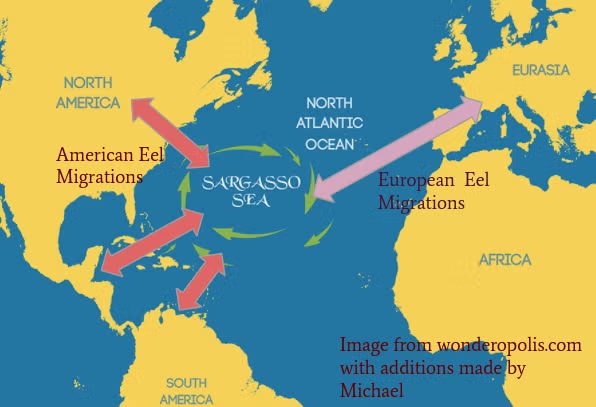

Unfortunately, this ↓ is starting to look more like this ↓


- Ocean currents have caused the accumulation of plastic in the Sargasso Sea creating the North Atlantic Garbage Patch, estimated to be hundreds of Km in size.
- This causes negative impacts on freshwater eel migrations and breedings, as a result of all the plastic pollution.
- We can help by reducing our plastic waste, supporting laws to decrease plastic use, and supporting research about plastics in our oceans.
Why are Eels Important?
- Eels are a critical food source for many birds, mammals, and large fish
- Eels are a top predator in many river or stream ecosystems, meaning they help maintain biodiversity by making sure one species of fish doesn’t take over the ecosystem
- Eels are important for keeping rivers and streams clean
- Eels transport the larva of filter-feeding mussels around freshwaters
- These mussels filter out pollutants from the water, keeping the environment and people healthy
- When eels disappear, the mussels do as well
- Eels are important in preserving balanced ecology, due to the several aquatic interactions eels are involved in
Past Conservation Efforts: A Brief History of American Eel Conservation
- In the past several decades American eel populations have declined by over 50%.
- The endangerment of other eel species worldwide have led to high demand for American eel.
- In 2011, a tsunami in Japan led the Japanese eel populations to decline (a species that is already endangered).
- In 2012, much of Europe banned the harvest of the European eel (a critically endangered species).
- Leading to increased harvesting of American eel to meet the high demand for eel in countries that had previously depended on Japanese and European eels.
- There have been attempts to include the American eel on the Endangered Species Act list (most recently in 2015) but efforts have failed meaning American eels have no protections.
Eel Conservation Is In Your Hands
A lack of laws protecting American eels mean consumers have to make conscious decisions on their own when purchasing and ordering seafood to protect the species from extinction and to ensure healthy ecosystems thrive for future generations.
How can we do this?
Supporting a sustainable future for eels!
What Will a Sustainable Future for Eels Look Like?


When looking at a sustainable future for eels, there are several aspects we must look at in order to attain sustainability in the future like social, environmental and economic aspects of eels in general. These photos are from the Sustainable Eel Group Code of Conduct for a Responsible Eel Sector.

The Monterey Bay Aquarium’s Sustainable Seafood Guide: Eels
The Monterey Bay Aquarium has developed a sustainable seafood tool that can help consumers make educated choices when purchasing seafood. Specifically for eels, you can use this website to see recommendations for sustainable seafood options for eel consumption. You can input information about the kind of eel, farmed or wild caught, and if it’s from a domestic or international location to determine if it’s good to purchase or should be avoided.

Within this example, the type of eel chosen is American eel, farmed, and domestically caught, producing two recommendations to avoid purchasing these eel choices.
The Monterey Bay Aquarium’s Seafood Watch Guide for Michigan
To help educate the public, the Monterey Bay Aquarium has produced a guide for choosing sustainable seafood options for each state through their Seafood Watch guides. This image shows our guide for the state of Michigan that we can use when choosing what seafood to consume! As alternative options to choosing eel, which is largely unsustainable.
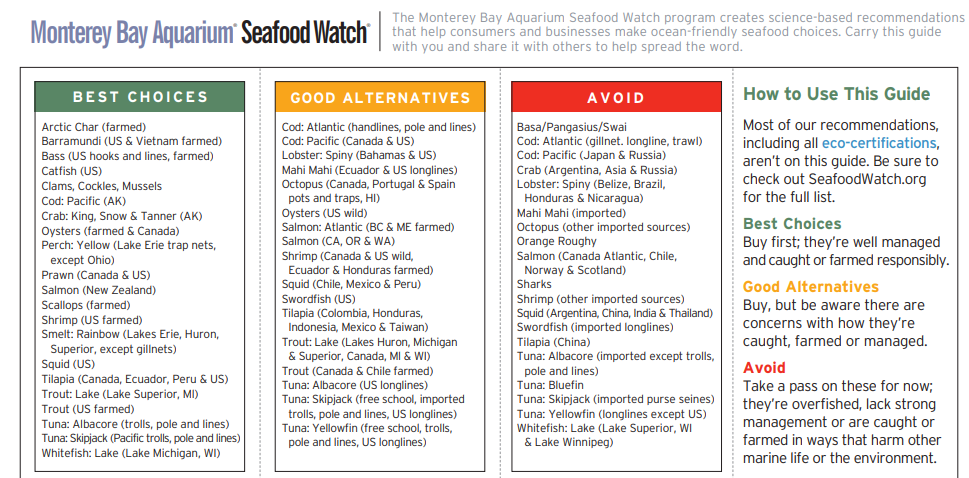
Included in the photo is the Monterey Bay Aquarium’s printable guide for choosing sustainable seafood options in Michigan. This can be used while in the grocery store and choosing what types of seafood to purchase.
Sustainable Eel Farming
“The production of eels is considered 100 percent reliant on endangered and critically endangered wild populations for farm stock” says the Monterey Bay Aquarium Seafood Watch, so even the “sustainable” eel farming is not the best option.
One option that the Monterey Bay Aquarium has as a “Good Alternative” is the American eel (glass eel) raised using fyke nets located in the Northwest Atlantic oceans and North American inland waters.


Glass eel fisheries harvest eels as they return from ocean spawning areas to freshwater, using fyke nets to collect glass eels. Bycatch rates are generally low in fyke nates, also making them more sustainable since other species are not being greatly impacted.
Sustainable Eel Options
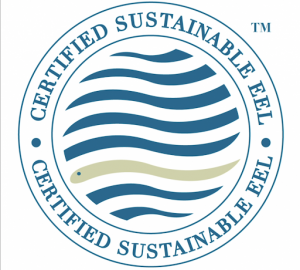
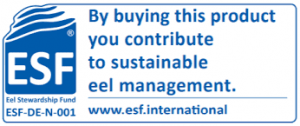 If you’re looking for sustainable eel be sure to check for the Sustainable Eel Group or the Eel Stewardship Fund logo on products that you purchase. We want consumers to be aware that their choices have consequences on eel populations that are endangered or threatened. When consumers buy products with these logos, they are supporting responsible and sustainable practices in eel fishing, farming and packaging.
If you’re looking for sustainable eel be sure to check for the Sustainable Eel Group or the Eel Stewardship Fund logo on products that you purchase. We want consumers to be aware that their choices have consequences on eel populations that are endangered or threatened. When consumers buy products with these logos, they are supporting responsible and sustainable practices in eel fishing, farming and packaging.
Shopping and Ordering Sustainable Eel and Seafood
Learning how to identify sustainable seafood can be difficult because it is hard to identify small labels on packaging and can be uncomfortable if you are unsure what to ask.
Next time you are ordering food at a restaurant with seafood, look on the menu for a sustainability label. If one is not present ask your server, “Was this seafood sustainability caught?” “Can I speak to the chef if you are unsure?” At the grocery store, be sure to look for seafood with labels that say, “Sustainability fished” or “Farmed Responsibly.” If there is not a label present, ask the fishmonger, “Is this seafood sustainably fished/farmed?”


Alternative Options to Eel
When looking to eat sushi with eel, instead look for alternatives like sushi with sustainably fished seafood or vegetables. If you do want to eat eel, make sure you are purchasing American eel raised in fyke nets in Northwest Atlantic oceans and North American inland water because this is the most sustainable option! You can find this out by looking on the restaurant menu, if you are not sure ask your server. At the grocery store, if the packaging is not labeled, ask the fishmonger to be sure you are purchasing sustainable seafood! Make sure to look for sustainable seafood labels.
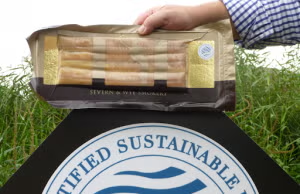

An Alternative to Eel: Help your wallet and Try this Cheaper, Healthier Option!
Eel sushi, and sushi in general, can also be quite expensive. To combat the cost of buying eel sushi while still getting your seafood fix, an alternative you can turn to is making your own poke bowls from home! Poke bowls are healthier, cheaper, and more filling options to still have seafood as a part of your diet and choose what you want in your meal!
By purchasing your own sustainable seafood using the Seafood Watch guide or finding a seafood label, you can put together an option that is better for the environment, cheaper, and just as satisfying! With hundreds of recipes online for making your own poke bowls at home, this option is quite feasible!
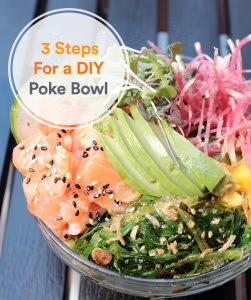
Sushi options around University of Michigan

The Future for Sustainable Eels in Ann Arbor
Ann Arbor’s restaurants that we called and spoke to did not have any information about the sustainability of the products that they were selling. Employees didn’t even know what species of eel they were selling!
There needs to be laws in place that require restaurants to tell customers where they are getting their products from and how their seafood is caught in order for the customers to be informed when they are making decisions about buying and eating eels. This will allow customers to make sustainable seafood choices and be more aware of what they are eating.
So, What Can YOU Do?
Show Your Support for Eel Conservation!
Sign this petition (*not yet an active petition, we are working on creating one!) to tell our Ann Arbor city officials to require restaurants to keep an updated information sheet on all the seafood they buy.

Sign this petition (*not yet an active petition, we are working on creating one!) to tell our Ann Arbor city officials to require restaurants to keep an updated information sheet on all the seafood they buy.
The next step for University of Michigan students is to take action and sign petitions that will mandate all restaurants to disclose whether products are sustainably fished or not and to make sure, when they do eat seafood, that the products they are eating were raised sustainability.
By doing so, University of Michigan students can help save aquatic animals and continue to support fishers that are keeping marine ecosystems balanced and thriving for generations to come.
GO BLUE!!


